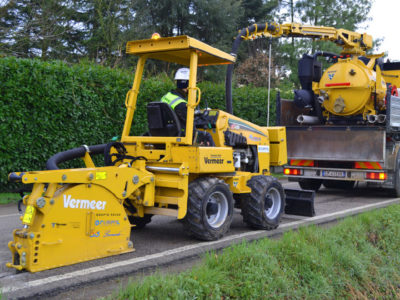Picture this: You’ve dug a trench and installed the utility line or conduit. Everything went well, and now the only thing left to do is backfill the trench and clean up. But what do you fill it with? What’s the best way to backfill it? The answer depends on a couple of factors, which we’ll talk about below.
Backfill material options
First, let’s talk about the different options. There are two main choices for backfill material: grout and epoxy.
Grout (also known as slurry) is prepared in a grout mixer on the jobsite and then poured into the trench. Obviously, this requires a grout mixer and then an efficient way to pour it into the trench itself.
The other method is epoxy. Preparation for epoxy is a little different than grout because it requires mixing both parts of the epoxy together and filling the trench with it before it starts to set. This needs to be a quick process, so having everything prepared before you mix the epoxy is important.
“Usually, the decision to use grout or epoxy is decided by the governing body or company that you’re contracted with, such as the telecom company,” explained Ed Savage, Vermeer product manager. “At the end of the day, you want to backfill it with material that you think will best protect the product.”
Whether you use grout or epoxy, the important part is you have enough backfill material on hand to adequately fill in all of the trench.
Cleanup processes
After you’ve backfilled the trench, it’s time to top it off with some cleanup. How you clean up depends on the surface you’re working with.
“If you’re trenching in asphalt, one option is to put an asphalt cap on top of the trench after the grout or epoxy has set,” said Savage. “That way,you have a similar surface with the rest of the road, which should wear at the same rate over time.”
If you’re trenching in concrete, then you’ll want to make sure that the backfill material you use is level with the rest of the concrete.
In both cleanup processes, the goal is to leave the surface looking like it did before, as much as possible. There’s also a backfill blade attachment for Vermeer ride-on tractors to help level and clean up the area as you backfill.
Backfilling the trench, cleaning up the area and restoring the surface is a crucial part of every microtrenching job. Digging the trench and installing the product gets most of the spotlight, but how you restore the cut also says a lot about the quality of your work and your attention to detail. Don’t neglect the care it takes to backfill and restore the cut well.
For more information about microtrenching and backfill material, contact your local Vermeer dealer.
Vermeer Corporation reserves the right to make changes in engineering, design and specifications; add improvements; or discontinue manufacturing at any time without notice or obligation. Equipment shown is for illustrative purposes only and may display optional accessories or components specific to their global region. Please contact your local Vermeer dealer for more information on machine specifications.
Vermeer and the Vermeer logo are trademarks of Vermeer Manufacturing Company in the U.S. and/or other countries. © 2021 Vermeer Corporation. All Rights Reserved.
